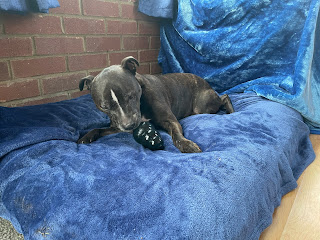Resilience
We often talk
about building resilience in our dogs but what is it and how can we do it?
The dictionary
description is that resilience is the ability to adjust or recover from
adversity, major life changes or to recover from illness or a crisis.
Resilience can
prevent trauma; help overcome it or create healing from psychological or
physical trauma.
It is not just
about early experiences although we can try to give our puppies the very best
start in life. The amount of resilience a dog has is influenced by his genetic
makeup, early exposures, and the current situation. Resilience can be damaged
by life experiences. All dogs need resilience to cope with life but dogs who
have experienced trauma need it even more. Resilience comes from the inside.
Resilience
requires:
• a dog to feel
safe – avoid dogs being overwhelmed in situations. If they become overwhelmed,
remove them from the situation. Find out what the triggers are and try to avoid
as many of them as you can while we build confidence. Try to walk in quieter
places if your dog is worried by other dogs or people.
• a dog to have
social support – this can be a human or another dog. This doesn’t mean simply
hugging and reassuring a dog when he is fearful. It means being there and
responding to his needs, being trustworthy, predictable and fun.
• a dog to be
able to make choices – use positive reinforcement and find ways to give your
dog choices in their life. If a dog does not want to engage in training or an
activity and walks away, let him! Dogs need to be able to say no. Use the
consent test to see if he wants physical touch and affection.
• a dog to feel
more confident – use scentwork.
The more
control a dog feels he has over his own environment and the ability to be able
to communicate his needs, the easier he will find it to make better decisions
and the more resilient he will be. Every single dog has the ability to become
resilient.
Remember the
5 C’s
Calm,
Connection, Choices, Consistency = Confidence
Tiira K.
(2019). Resilience In Dogs? Lessons From Other Species. Veterinary medicine
(Auckland, N.Z.), 10, 159–168. https://doi.org/10.2147/VMRR.S189566


















